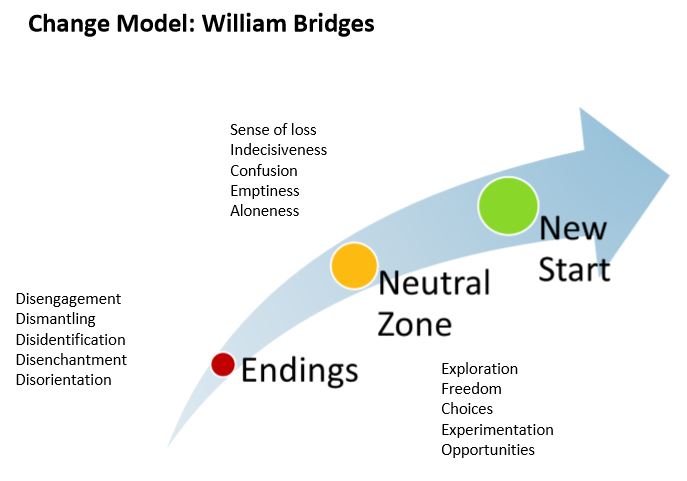What is the biggest change you have ever experienced in life and how well did you lead through it?
How long did it take you to move from ‘the fog’ that overtakes you in a big change to a place where you could see new opportunities?
I believe transitions are the single biggest place for growth and pain. It is also the place where big personal changes provide us an opportunity to develop the wisdom and experience that translates back into our ability to lead change at work. The researchers call this resilience. The regular word we use in daily conversation is wisdom. Here are two lenses to help you develop the capacity to lead change. Next time you hit a change of any sort, use one of these to reflect, act, and grow.
Lens #1: William Bridges – This model is presented in more detail in his book, Transitions, and is a powerful lens through which to see our personal transitions in a different way. I have  used it extensively with people in career transitions or any other job-related change. It is based on a recognition that in personal changes we need to let go of things (Endings) before we can see our situation in a new way (Neutral Zone). In the Neutral Zone, painful and confusing feelings still exist (emptiness, confusion, alone-ness) until we actively begin to try new things, which ultimately move us to a New Start. Yes, we do slide back, and in highly complex changes, multiple endings emerge that force us to retrace our steps. Here is a real example of how the model plays out in a career change:
used it extensively with people in career transitions or any other job-related change. It is based on a recognition that in personal changes we need to let go of things (Endings) before we can see our situation in a new way (Neutral Zone). In the Neutral Zone, painful and confusing feelings still exist (emptiness, confusion, alone-ness) until we actively begin to try new things, which ultimately move us to a New Start. Yes, we do slide back, and in highly complex changes, multiple endings emerge that force us to retrace our steps. Here is a real example of how the model plays out in a career change:
It was the first day of our 3-month career transition program. During the check-in, she talked about how she was a teacher, and the idea of leaving her profession made her feel guilty for abandoning her kids and losing her summers. (Can you hear the endings in those statements?) After a few classes and different exercises, she shared that she was beginning to see herself as someone who had a passion for helping people, and was skilled at using learning to assist people to grow and contribute more in their work. She was also wondering where that fit in the business world? Admittedly, she was still feeling anxious about actually working in a business. (Can you hear the neutral zone clues?) In our last conversation, she was two weeks into an internship with a business helping them pull together customer training for a new product they were launching. She was excited about the realization that learning for adults was like the hands-on/experiential approach she used in her classes. She was also excited about how quickly the learning showed up in performance. Having the summer off was still something she was not sure she wanted to give up.
Lens #2: 3 Ps by Martin Seligman – In her book Option B, Sheryl Sandberg shares a model explaining the barriers to personal recovery in life events. If you don’t know her story, Sandberg is the COO at Facebook and lost her husband from a heart attack a couple of years ago. Here are the 3 Ps that stunt personal recovery from events in our lives:
- Personalization – The belief we are at fault.
- Pervasiveness – The belief that an event will affect all areas of our life.
- Permanence – The belief that the aftershocks of an event will last forever.
Studies have shown that adults and children will recover more quickly when they realize it was not their fault, begin to see the positives in other aspects of their life that were not taken away by the event, and begin to see improvement and healing through the gift of time.
While the Seligman 3 P model is generally applied to big life events like death, divorce, job loss, or abuse, can you hear the similarities with what Bridges shares? For those of you that have navigated such a life event, how has that translated back into how you lead others?
Change will happen inside and outside of work, and each event is an opportunity to develop the personal ability to navigate those changes, which becomes the foundation for all of us to be great leaders of change.
For leaders, here are the three truths that you need to take into any change conversation:
- It is a studied process, so rely on a model to plan the change.
- It takes time, so the sooner you start planning, the better.
- You cannot control how people react, but you can control creating conditions where people feel supported/safe and are invited to take the next step in change.
The #1 reason leaders struggle with change is because they cannot control the choices others make. The #2 reason they struggle with change is because they have not allowed people the time they need to process change, especially the big ones.
The third issue that trips up leaders in navigating change is that it requires the help of others. In the next post, we will explore what I call The Power of 2.
Download a free one-pager on change. It includes the Bridges model, and also an additional tool that works well with planning organizational changes from Scott & Jaffe.
Lead well!

